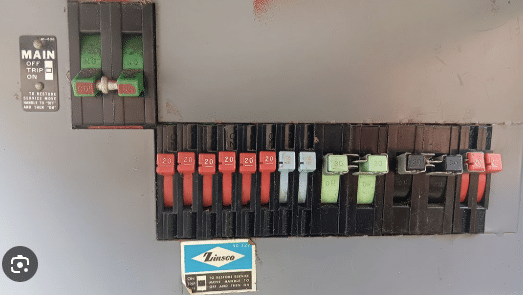
Electrical panels are the heart of the electrical system — distributing power safely to every outlet, light, and appliance. But not all panels were built equally. Some older brands have become notorious for safety defects, fire hazards, and failure to trip during overloads — putting you at risk.
If your panel was installed or rewired between the 1950s and early 2000s, it’s worth checking what brand of panel you have. Below are the most common problematic and hazardous electrical panels still found in homes today. NOTE: There are also more moderns breaker recalls for other brands, that are not included below. Those breakers can typically just be swapped out.
😌 Pro Tip:
If the breaker handles are colored (green, orange, red, blue, etc) it will almost always be one of these brands. NOTE: Some of the breakers below may ALSO have black handles!
🔥⚡️ Federal Pacific Electric (FPE) — 1950s – 1980
Known Fire/Shock Hazard
Federal Pacific panels — particularly those with Stab-Lok breakers — are among the most widely recognized electrical hazards in America. Independent testing has shown that a high percentage of FPE breakers fail to trip during short circuits or overloads, allowing conductors to overheat and catch fire.
Even if the panel appears to function, hidden defects can remain.
✅ Recommendation: Full replacement by a licensed electrician. FPE panels cannot be “repaired” safely because the design flaw lies in the breaker mechanism itself.
🔥⚡️ Zinsco (a.k.a. Sylvania-Zinsco) — 1950s – 1980s
Known Fire/Shock Hazard
Zinsco panels are another brand with a long record of failure. The aluminum bus bars and thin breaker clips often overheat, melt, and lose contact, sometimes leaving circuits permanently energized even when “off.”
Melted bus bars can cause internal arcing and serious fire risk.
✅ Recommendation: Immediate replacement. No retrofit or breaker swap is considered safe.
🔥⚡️ Sylvania (Certain Models) — Mid-1950s – Late 1980s
Known Fire/Shock Hazard
When Sylvania acquired Zinsco, many of the same internal designs continued under new labeling. Panels stamped Sylvania-Zinsco share identical failure modes — loose connections, overheating, and non-tripping breakers.
Although Sylvania still makes safe modern panels, the legacy versions from this era are unsafe.
✅ Recommendation: Replace any Zinsco-style or legacy Sylvania panel installed prior to the 1990s.
🔥⚡️ Bulldog / ITE Pushmatic — 1950s – 1980s
Known Fire/Shock Hazard
Pushmatic panels use a distinctive push-button breaker instead of the familiar toggle switch. Over time, these mechanisms become stiff or fail to reset, and the lack of a built-in main disconnect makes full shutdown difficult.
Some breakers also stick closed, preventing safe tripping under load.
✅ Recommendation: Replacement is preferred. Many breakers are no longer manufactured or UL-listed for use in these panels.
🔥⚡️ Bryant — 1950s – 1990s
Known Fire/Shock Hazard
Bryant panels were widely used in residential construction for decades. After ownership changes (Bryant → Westinghouse → Eaton/Cutler-Hammer), compatibility issues arose.
Older Bryant breakers can loosen on the bus and overheat, and replacements may not properly fit the original housing.
✅ Recommendation: Evaluate and replace if original Bryant breakers are still in service or if corrosion or discoloration is present.
🔥⚡️ Challenger — 1960s – Early 1990s
Known Fire/Shock Hazard
Challenger panels and breakers were subject to multiple recalls due to overheating bus connections and breaker failures. Many of these panels were installed in tract housing during the 1980s and early 1990s.
Even panels with the later “Eaton” label may contain Challenger-marked breakers still known to overheat.
✅ Recommendation: Replace panel or all Challenger breakers with modern UL-listed equivalents buy a licensed electrician.
🔥⚡️ Murray — 1950s – 2000s
Known Fire/Shock Hazard (particularly 2010 red-handle main breakers)
While older Murray panels were relatively dependable, the company’s red main breakers produced around 2010 were recalled for potential fire and shock hazards due to internal arcing and failure to trip.
These panels are often mistaken for Siemens units, as both brands share similar designs.
✅ Recommendation: Verify model number and recall status. Replace panel or main breaker assembly if affected.
✅ The ONLY Solution — Replace the Panel
For panels listed above, replacement is the only safe and insurable solution. Upgrading to a modern panel ensures:
- Breakers trip reliably under overload or short-circuit conditions
- Proper grounding and bonding
- Room for future circuit additions (EV charger, solar, etc.)
- Improved resale value and insurance eligibility
Avoid surprises during the sale or insurance process.
Pre-inspect for outdated or recalled electrical panels before listing or buying.
⚡ Protect your deal — and your clients — with a Trusted HomeStar Inspection!
